

Bald Eagle (Haliaeetus leucocephalus)
 |
| The bald eagle is known as a sea or fish eagle and is found along rivers and coastlines where tall trees are available for nesting. Most of the bald eagles found in Nevada are wintering here, though occasionally, nesting pairs are found in the northern part of the state. From November through March, Carson Valley may have between 15 to 50 eagles in the area. The wingspan of an eagle may be up to nine feet! Previously listed as endangered due primarily to bioaccumulation of DDT pesticides, numbers have rebounded and they have been down-listed in most of their range. |
| Video Link Click Here |
| Click Here for Audubon’s website |
| Click Here for National Wildlife Federation’s website |
| Click Here for Eagles & Ag Event’s website |

California Gull (Larus californicus)
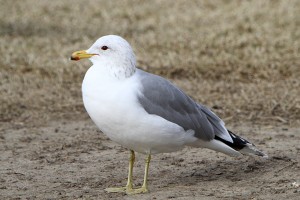 |
| The California Gull is distributed across rivers, ponds, lakes, and coastal areas of the western United States and Canada. The gull is medium sized with primarily white feathers and gray wings and back. The California Gull is the gull often seen in Nevada’s lakes and ponds. It’s native to Nevada and the state bird of Utah. In a natural setting, the California Gull feeds on small fish, insects, or raids the nests of other birds. This bird also feeds on scraps left by humans. |
| Click Here for Audubon’s website |
| Click Here for Cornell Lab of Ornithology’s website |

Red Fox (Vulpes vulpes)
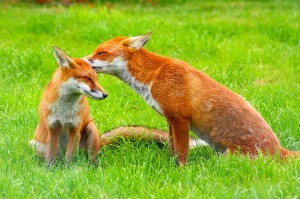 |
| The Red Fox is distributed across North America and can be found on the edges of forests, tilled fields, near marshes, on farmland, beaches, prairies, woodlands, and both alpine and arctic tundra. This small, doglike animal is rusty-red with white under parts, chin and throat. Because of its well-developed sense of hearing, sight, and smell the red fox is an efficient and lethal predator. Being an omnivore it eats whatever is available including corn, berries, apples, grasses, birds and mammals. |
| Click Here for Nature Work’s website |
| Click Here for State University of New York’s website |

Bobcat (Felis rufus)
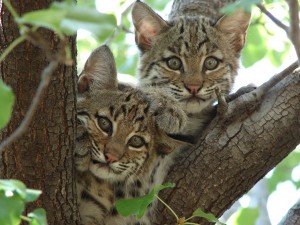 |
| Bobcats are found in almost all types of habitat especially in mountains and even in desert areas where water is available. The name Bobcat may have originated from its short tail, which is only 6 or 7 inches long. Bobcats are equipped to kill animals as large as deer. When living near a ranch, it may take lambs, poultry and even young pigs. However, food habit studies have shown Bobcats subsist on a diet of rabbits, ground squirrels, mice, pocket gophers and wood rats. |
| Click Here for Nevada Department of Wildlife’s website |
| Click Here for Defenders of Wildlife’s website |

North American Porcupine (Erethizon dorsatum)
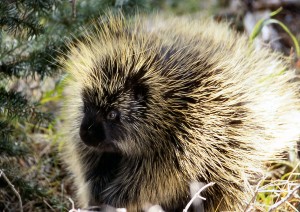 |
| The Porcupine is distributed throughout all the North American desert regions north to Canada. The North American Porcupine is a heavyset, short-legged, slow-moving rodent that is usually solitary, nocturnal, herbivorous, and spends much of its time in trees. The Porcupine's barbed quills detach easily and can become painfully embedded in the skin of an attacker. Not only do they inflict painful wounds, but they also work into the skin and may even cause death if they puncture vital organs or if the wounds become infected. |
| Click Here for Desert USA website |
| Video Link Click Here |
 |
| The Porcupine is distributed throughout all the North American desert regions north to Canada. The North American Porcupine is a heavyset, short-legged, slow-moving rodent that is usually solitary, nocturnal, herbivorous, and spends much of its time in trees. The Porcupine's barbed quills detach easily and can become painfully embedded in the skin of an attacker. Not only do they inflict painful wounds, but they also work into the skin and may even cause death if they puncture vital organs or if the wounds become infected. |
| Click Here for Desert USA website |
| Video Link Click Here |

Pronghorn Antelope (Antelocapra americana)
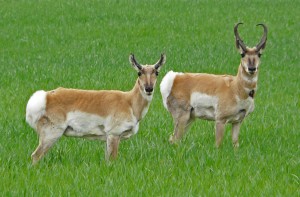 |
| Pronghorn prefer gentle rolling to flat, wide-open topography. Low sagebrush and northern desert shrubs are the preferred vegetation types. Areas such as these with low understory allow antelope to see great distances and permit the animals to move quickly to avoid predators. Over 150 different species of grasses, forbs and browse plants are eaten by antelope, which allows them to occupy a variety of habitat types. Succulent plants and sprouts are preferred. Some of the main components of pronghorn diet in many locations include sagebrush, antelope bitterbrush, saltbrush, rabbitbrush, cheatgrass, indian rice grass, crested wheat grass, lambs quarter and shadscale. |
| Click Here for Nevada Department of Wildlife’s website |
| Video Link Click Here |

White-tailed Jack Rabbit (Lepus townsendii)
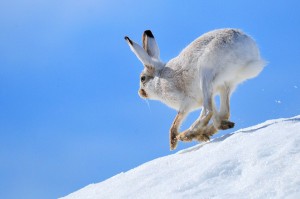 |
| The White-tailed Jack Rabbit has very long ears and legs and a white tail. It is classified as a small game animal in Nevada, where it habitats mountainous terrain and areas with sagebrush. It is a strict herbivore and eats green plants, flowers, sagebrush, and cacti. The Jackrabbit has a lifespan of 1-5 years and breeds from late February to mid-July. Females bear 2-4 litters of 1-11 young per year. The young are born in cavities or burrows dug into the vegetation. The jack rabbit is also a historic food and clothing source for the Washoe Indian tribe. |
| Click Here for Nevada Department of Wildlife’s website |
| Video Link Click Here |

Mountain Yellow-Legged Frog (Rana muscosa)
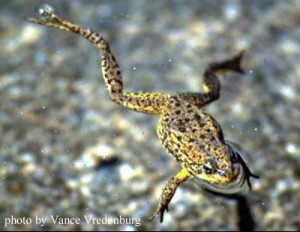 |
| The Mountain Yellow-Legged frog is a rare frog that is distributed across northwestern Nevada. This frog prefers sunny stream banks and undisturbed ponds and lakes. Adults are highly aquatic and are rarely found far from water. Populations are currently under study in the watershed and have been listed as threatened and endangered by the U.S. Fish and Wildlife Service. |
| Click Here for National Park Service’s website |
| Click Here for California Department of Fish and Wildlife’s website |

Yellow Bellied Marmot (Marmota flaviventris)
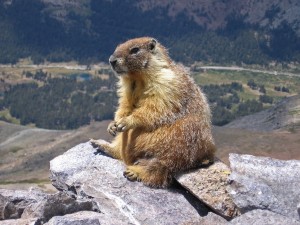 |
| Yellow Bellied Marmots range from southwestern Canada throughout the western United States. They generally occupy open habitats such as steppes, alpine meadows, pastures, gravel-covered fields and forest edge. These marmots prefer to construct their burrows on open, grassy or herb-covered slopes. The marmot’s diet consists of the leaves and blossoms of a great variety of herbaceous plants and grasses. They also consume fruit, grains, legumes, and occasionally insects. They largely forage for seed in the late summer. |
| Click Here for National Park Service’s website |
| Click Here for Nature Mapping Foundation’s website |

Brown Trout (Salmo trutta)
 |
| The brown trout is native to Europe and western Asia and was introduced into North America in 1883. It can be found in waters throughout the Carson River Watershed. Brown trout spawn in late autumn to early winter in shallow, gravelly waters. The female digs a hole where she lays about 2000 eggs. This species is carnivorous and feeds on insects, crustaceans especially crayfish, mollusks, salamanders, frogs and rodents. |
| Click Here for National Park Service’s website |
| Click Here for Nevada Department of Wildlife’s website |

Striped Skunk (Mephitis mephitis)
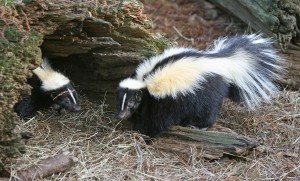 |
| The Striped Skunk can be found in rural areas, agricultural lands, and urban areas in western North America. Adults can grow to about 4 feet long and have black bushy fur with a white stripe from its head to tail. Skunks survive on a diet of reptiles, young birds, small mammals, and eggs. As a defense mechanism, skunks spray any potential enemies. Before they spray, skunks arch their backs, stamp their feet, click their teeth, raise their tails and snarl softly to warn enemies. Those that ignore these warnings get a sprayed, which can cause intense pain, vomiting, and temporary blindness. |
| Click Here for Defenders of Wildlife’s website |
| Click Here for State University of New York’s website |

Barn Owl (Tyto alba)
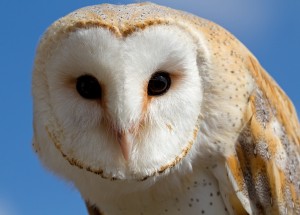 |
| The Barn Owl is distributed throughout North America except in high altitudes. This owl hunts in areas rich in rodents, along desert washes and canyons, where trees for perching are available. The owl nests and roosts in barns and tree cavities. The Barn Owl is primarily white with buff, yellow and tawny shadings. It is delicately freckled with dark specks and the blending of colors in day-light has led some to call it, the "golden owl." When hunting at night, the Barn Owl sweeps fields catching its prey with its long, slender claws. It prefers small mammals but occasionally in winter when mice and gophers are scarce, it will consume small birds. |
| Click Here for Audubon’s website |
| Click Here for Cornell Lab of Ornithology’s website |

Stellar’s Jay (Cyanocitta stelleri)
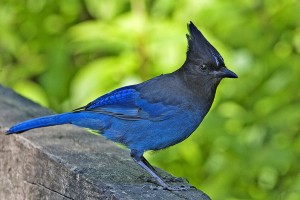 |
| The Stellar’s Jay is distributed across western North America. Stellar’s Jays breed primarily in dense conifer forests, but they use a wider variety of forested habitats at other times of year. Stellar’s Jays are omnivores, and their diets are about 2/3 vegetable-matter and 1/3 animal-matter. The vegetable portion of their diet consists of seeds, nuts, berries, and fruits, and the animal-matter portion consists of bird eggs and nestlings, invertebrates, small rodents, reptiles, and carrion. They eat almost any scraps that humans give them. They appear to be major predators of other bird species’ eggs. |
| Click Here for Audubon’s website |
| Click Here for Cornell Lab of Ornithology’s website |

Kit Fox (Vulpes macrotis)
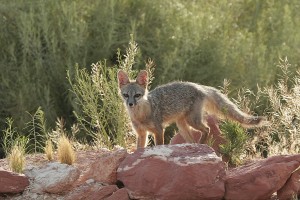 |
| The Kit Fox inhabits rocky, brushy desert of Nevada and the adult males grow to the size of a small dog. They are nocturnal hunters and scavengers that feed on small mammals, fish, and birds. The Kit fox lives in burrows that they dig themselves or enlarge a den they have taken over. They raise a litter of 4-7 pups that wean in 10 weeks and live with the parents from spring to early fall. |
| Click Here for Wildscreen’s website |
| Video Link Click Here |

Golden Eagle (Aquila chrysaetos)
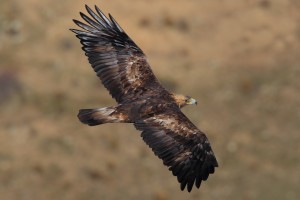 |
| The range of the Golden Eagle extends throughout most of the Northern Hemisphere. The golden eagle reaches speeds of 240 to 320 km/h when diving. Most of its mammalian prey (foxes, rabbits, hares) are taken on the ground. Large birds, such as geese and cranes, are occasionally struck in midair. Nests are built on crags or trees and are sometimes occupied for generations. The young hatch at intervals of several days and in cases where two young hatch, the elder may kill the younger. |
| Click Here for the Canadian Museum of Nature’s website |
| Video Link Click Here |

Osprey (Pandion haliaetus)
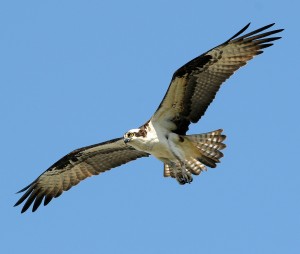 |
| Ospreys can live almost anywhere where there are safe nest sites and shallow water with abundant fish. Ospreys are large birds of prey (55 to 58 cm long), with a wingspan ranging from 145 to 170 cm. Their long wings have a characteristic bend at the carpal ("wrist") joints. They are bright white underneath, with deep brown patches at the carpal joints and a mottled deep brown necklace. |
| Click Here for the University of Michigan’s Museum of Zoology website |
| Video Link Click Here |

Black Bear (Ursus americanus)
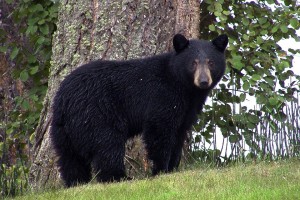 |
| Black bears are not always black. They also come in shades of cinnamon and brown. They have large ears a long snout and round head that distinguishes them from grizzly and brown bears. The American black bear is the only bear species occurring naturally in Nevada. Range includes mountainous areas and foothills of Lake Tahoe, the Sierra Nevada Mountains and nearby mountain ranges in extreme western Nevada. Black bears are omnivorous. They will graze on grass and browse on berries and blossoms, dig grubs, catch fish and small mammals and scavenge carrion. Prior to winter hibernation, black bears seek to consume more than 20,000 calories a day in attempt to add 60-80% of its body weight so it can sustain itself through the winter. |
| Click Here for Defenders of Wildlife’s website |
| Click Here for National Park Service’s website |

Marsh Hawk (Circus cyaneus)
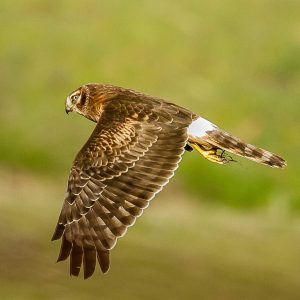 |
| The Marsh Hawk, also known as the Northern Harrier, is common throughout all of North America. It is present in all the continental states as well as Canada. The Marsh hawk has an owl-like face, long, rounded wings, long tails and most have a white patch on their behind. They mostly fly low, over open areas like marshes or grasslands searching for prey. When they spot their prey, they flap their wings a few times before diving down at an incredible speed to snatch up their meal, which is devoured on the spot. |
| Click Here for Audubon website |
| Video Link Click Here |

White Bass (Morone chrysops)
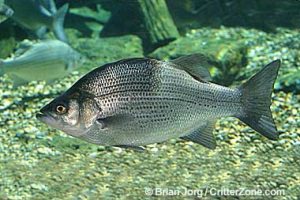 |
| White Bass is found in Lahontan Reservoir and is commonly stocked as a popular recreational fish for anglers. It is classified as non-native and is dark grey to black on the back, with light, silvery sides and white belly. White Bass love to eat shad and spend much of their time chasing schools of shad. White Bass are a migratory open-water fish which is most active during dawn and dusk. |
| Click Here for the Nevada Department of Wildlife’s Website |
| Video Link Click Here |

Western Terrestrial Garter Snake (Thamnophis elegans)
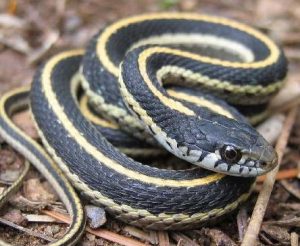 |
| Western terrestrial garter snakes are often found by water and spend most of their time on land. Even though they are terrestrial (earth-bound), they sometimes enjoy a good swim. These snakes are common throughout western states and their diet includes earthworms, fish, frogs, toads, lizards, other snakes, small mammals and sometimes birds. They have a yellow stripe down the middle of their back and sometimes have red flecks, checkers or stripes on their sides. They can reach a length up to 3 and a half feet. |
| Click Here for Truckee River Guide Website |
| Video Link Click Here for Snake Den Video |

Raccoon (Procyon lotor)
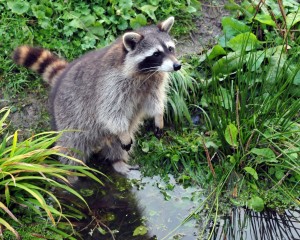 |
| The raccoon is a reddish-brown above and black or grayish below. The most prominent characteristics are the bushy tail with 4-6 black or brown rings and the black mask outlined in white. The raccoon is most common along stream edges, open forests and coastal marshes. Omnivorous, it feeds on nuts, grubs, crickets, small mammals, birds'' eggs and nestlings. Often seen washing their food, the raccoon is feeling for matter that should be rejected as the wetting of the paws enhances its sense of feel. Winter is the raccoon's greatest enemy when food is scarce. |
| Click Here for Bear Tracker website |
| Video Link Click Here |
 |
| The raccoon is a reddish-brown above and black or grayish below. The most prominent characteristics are the bushy tail with 4-6 black or brown rings and the black mask outlined in white. The raccoon is most common along stream edges, open forests and coastal marshes. Omnivorous, it feeds on nuts, grubs, crickets, small mammals, birds'' eggs and nestlings. Often seen washing their food, the raccoon is feeling for matter that should be rejected as the wetting of the paws enhances its sense of feel. Winter is the raccoon's greatest enemy when food is scarce. |
| Click Here for Bear Tracker website |
| Video Link Click Here |
 |
| The raccoon is a reddish-brown above and black or grayish below. The most prominent characteristics are the bushy tail with 4-6 black or brown rings and the black mask outlined in white. The raccoon is most common along stream edges, open forests and coastal marshes. Omnivorous, it feeds on nuts, grubs, crickets, small mammals, birds'' eggs and nestlings. Often seen washing their food, the raccoon is feeling for matter that should be rejected as the wetting of the paws enhances its sense of feel. Winter is the raccoon's greatest enemy when food is scarce. |
| Click Here for Bear Tracker website |
| Video Link Click Here |

Beaver (Castor Canadensis)
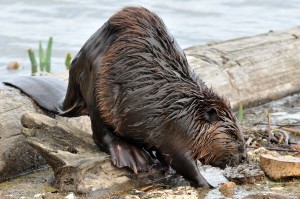 |
| The Beaver lives in rivers and ponds throughout Nevada. Beavers are large rodents with thick fur and flat, paddle-like tail that is used as a rudder when swimming and slapped on the water as an alert or alarm call. Beavers will construct dams and lodges out of gnawed willows and trees or dig back into banks to build a lodge. Beavers must chew, and will even chew trees much larger than they need. Beavers eat several kinds of herbaceous plants as well as the leaves, twigs, and bark of most species of woody plants. Beavers have up to two litters per year with 6-12 kits per litter. Beaver were introduced to the Carson River in the 1940s-50s to help control erosion. Their populations have grown out of control because they have few predators in the watershed. |
| Click Here for University of Michigan’s Museum of Zoology website |
| Video Link Click Here |

Common Nighthawk (Chordeiles minor)
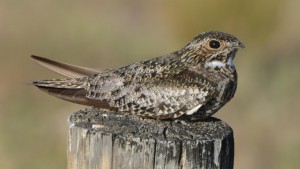 |
| The Nighthawk can be found in open woodlands, clearings, or fields. It is a jay-sized bird, mottled brownish-black above and below, perfectly matching the ground. Long notched or square-tipped tail and long pointed wings with broad white wing bar. On its breeding grounds, the male does a power dive and then, as it swerves upward, makes a booming sound with its wings. Analysis of stomach contents has shown that in a single day one bird captured more than 500 mosquitoes and another ate 2,175 flying ants. |
| Click Here for The Cornell Lab of Ornithology website |
| Video Link Click Here |

Pica (Ochotona princeps)
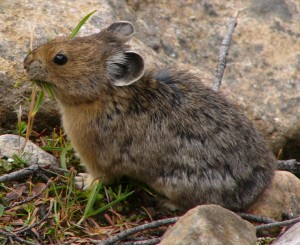 |
| The Pica is distributed across North America and can be found in mountainous regions because they prefer high altitudes. The Pica is a small mammal that has large, round ears with a hamster-shaped body. Because of the high altitudes in which it lives, the Pica has adapted to the harsh mountainous climate by spending most of the year in a burrow to avoid the cold temperatures. Because it doesn’t hibernate, the Pica collects grasses during the summer and drying it in the sun to save it all winter. |
| Click Here for Travel Nevada website |
| Video Link Click Here |

Coyote (Canis latrans)
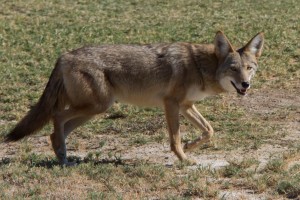 |
| The coyote is a member of the dog family (Canidae) and resembles a medium-sized shepherd-collie type dog. Distinguishing characteristics include sharp pointed ears, a pointed nose, and a long bushy tail. From the low desert valleys to the alpine ridges coyotes are found in about any type of habitat where they can find food and a place to hide. They seem to show some preference for brush covered rolling hills and flats. Coyotes have perhaps the most varied habitat of any animal in Nevada. Coyotes will eat almost anything available to them where ever they are; fruits, rodents, small animals, and garbage. Communication helps coyotes to maintain their social structure. The most distinctive of their calls is barking and yelping followed by a long howl that is followed by short, sharp yaps. This broadcasts their location to other members of their group. |
| Click Here for Nevada Department of Wildlife’s website |

Mountain Bluebird (Sialia currucoides)
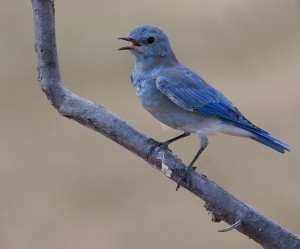 |
| The Mountain Bluebird is the official bird of the state of Nevada and can be found breeding in the foothills and mountains of western North America. The Mountain Bluebird’s head, back, wings, and tail are bright blue. Bluebirds nest in relatively open areas such as such as meadows, hayfields, grain fields, savannas, prairies, clear cuts, and the edges of coniferous and deciduous forests. They feed on a variety of insects, but unlike their relatives, rarely eat berries or seeds. Mountain Bluebirds migrate to the southern United States and central Mexico, where they inhabit open lowlands, desert plains, and grasslands. |
| Click Here for Nevada Department of Wildlife’s website |
| Video Link Click Here |

Burrowing Owl (Athene cunicularia)
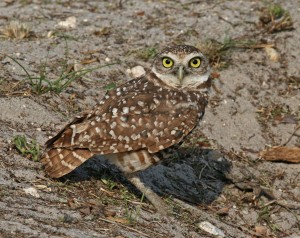 |
| The Burrowing Owl is a relatively small owl with sandy colored head, back and wings and white breast and belly. It is found in western North America in habitats composed of open dry shrub/steppe grasslands, agricultural and range lands, and desert habitats associated with burrowing animals. The Burrowing Owl got its name from nesting in holes made from burrowing animals such as gophers. It is classified as a bird of prey because it eats small mammals such as mice or ground squirrels, but it also feeds on arthropods, reptiles, birds and bats. |
| Click Here for Nevada Department of Wildlife’s website |
| Video Link Click Here |

Least Chipmunk (Tamius minimus)
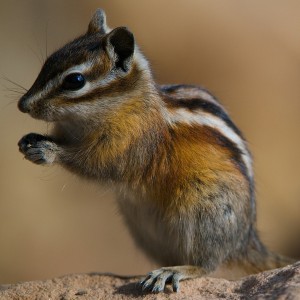 |
| The Least Chipmunk is a small mammal distributed across western North America and has 2 black stripes that run through its eyes and down its back. This is the only true chipmunk in Nevada and it lives in burrows or hollows of trees. The chipmunk is found primarily in rocky mountainous regions. It feeds on a diet of seeds, berries, nuts, and the cones of conifer trees. It is distinguishable by the way it runs in short, quick spurts with its tail straight in the air. |
| Click Here for Nevada Department of Wildlife’s website |
| Video Link Click Here |

American White Pelican (Pelecanus erythrorhynchos)

Desert Horned Lizard (Phyrnosoma platyrhinos)
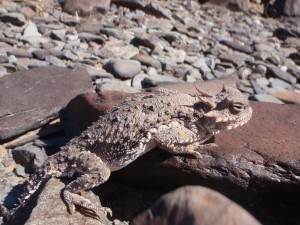 |
| Often called “Horny Toads” the Desert Horned Lizards live in rocky, desert regions with shrubby vegetation. They grow to about 6 to 8 inches long and are recognizable by their spiny collars, disc-shaped body, and short, sharp, serrated tail. This lizard primarily feeds on insects, particularly ants and small beetles that it catches with its quick tongue. |
| Click Here for California Herps website |
| Video Link Click Here |

Western Fence Lizard (Sceloporous occidentalis)
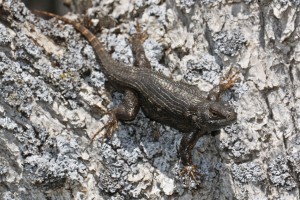 |
| Western Fence Lizards are distributed across Northern Nevada in rocky, desert, brushy, and urban areas. Adults are about 10 inches in length and have a blue-gray upper body with a light-gray lower body with dark stripes on the stomach and sides. These lizards mainly eat reptiles, eggs, and insects. |
| Click Here for the U.S. Fish and Wildlife Service website |
| Video Link Click Here |

Long-Billed Curlew (Numenius americanus)
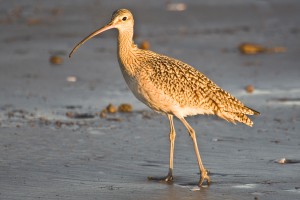 |
| The Long-billed Curlew is brown and buff below with cinnamon wing linings, and no head pattern. Their plumage blends well with the prairie grasses of their breeding habitat and they can be difficult to locate. The breeding habitat consists of prairies and grassy meadows usually near water where they consume grasshoppers, crickets, and beetles. |
| Click Here for the Audubon website |
| Video Link Click Here |

Snowy Egret (Egretta thula)
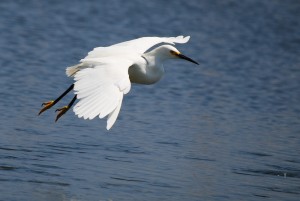 |
| The Snowy Egret can be found in North American streams, ponds, and lakes. It is a medium sized heron with white plumage and a black bill, and long legs. The snowy egret uses a thin veil of plumes in a showy courtship dance which both mates do face to face in the same manner. The Snowy Egret uses its long, sharp bill to probe the shallow, fresh waters of marshes and lakes for small fish, frogs and invertebrates. |
| Click Here for the Audubon website |
| Video Link Click Here |

Great Blue Heron (Ardea herodias)
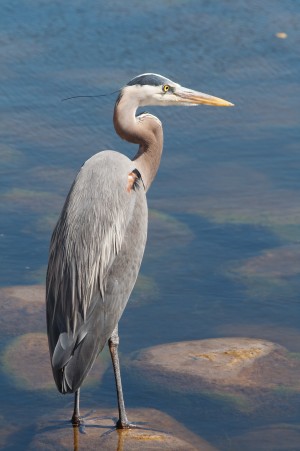 |
| The Great Blue Heron is distributed across North America and can be found in streams, ponds, and lakes. The Great Blue Heron has a tremendous wingspan. Its heavy beak, large eyes, streaked plumage and sweeping head feathers giving this bird a wild-eyed appearance. These birds are hunters that wade marshes and ponds searching for mice, birds, minnows or amphibians to eat. |
| Click Here for the Audubon website |
| Video Link Click Here |

Mallard (Anas platyrhynchos)
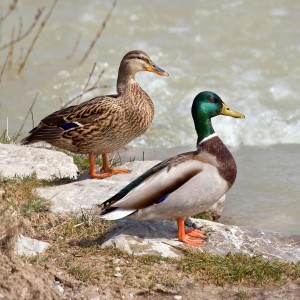 |
| The Mallard is probably the most widely known wild duck in North America. It is a medium-to-large dabbling duck that is most recognizable by the male's glossy green head and white collar around the neck. The female is an overall brown color. Mallards are very common throughout North America. As migratory waterfowl, they winter south of Canada, throughout the United States south to Central America. Mallards feed by "dabbling" and upending, meaning that they tip their bodies into water, bill first, tail in the air, to forage for food. Their diet is 90% vegetarian, consisting mainly of seeds of grasses, sedges, pondweeds and other aquatic vegetation. Snails, insects and small fish sometimes are taken. |
| Click Here for USGS website |
| Video Link Click Here |
 |
| The Mallard is probably the most widely known wild duck in North America. It is a medium-to-large dabbling duck that is most recognizable by the male's glossy green head and white collar around the neck. The female is an overall brown color. Mallards are very common throughout North America. As migratory waterfowl, they winter south of Canada, throughout the United States south to Central America. Mallards feed by "dabbling" and upending, meaning that they tip their bodies into water, bill first, tail in the air, to forage for food. Their diet is 90% vegetarian, consisting mainly of seeds of grasses, sedges, pondweeds and other aquatic vegetation. Snails, insects and small fish sometimes are taken. |
| Click Here for USGS website |
| Video Link Click Here |

White Faced Ibis (Plegadis chihi)
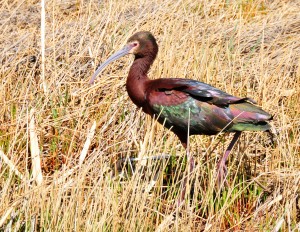 |
| The White-faced Ibis is a dark, chestnut colored-bird with green or purple on its head and upper parts, and a long, down-curved bill. The White-faced Ibis seems to prefer freshwater marshes, where it can find insects, newts, leeches, earthworms, snails and especially crayfish, frogs and fish. They roost on low platforms of dead reed stems or on mud banks. The White-faced Ibis frequents marshes, irrigated pastures, swamps, ponds and rivers. They are declining throughout North America, where continuing threats include draining of wetlands and the widespread use of pesticides. |
| Click Here for the Audubon website |
| Video Link Click Here |

Black Crowned Night Heron (Nycticorax nycticorax)
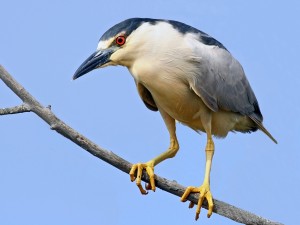 |
| The Black Crowned Night Heron is distributed across North American streams, ponds, and lakes. This bird’s diet consists primarily of fish and frogs that it waits for patiently. Like most herons, the black Crowned Night Heron often waits in a small pool or backwater for hours, standing perfectly still while its prey swims around it. |
| Click Here for the Audubon website |
| Video Link Click Here |

Canada Goose (Branta Canadensis)
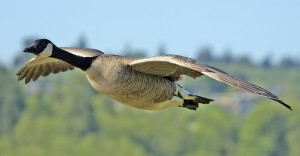 |
| The Canada Goose is a waterfowl of the Great Basin. It is a migratory bird that primarily nests in Canada and Alaska, but it also sometimes nests locally. There are usually 6-10 goslings per Canada Goose nest. The Canada Goose can be found throughout the Carson River watershed on agriculture lands, Carson River corridor, and golf courses. |
| Click Here for the Audubon website |

Desert Bighorn Sheep (Ovis Canadensis)
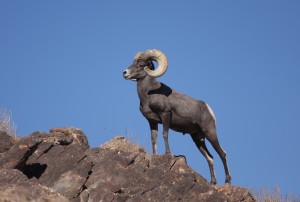 |
| The Desert Bighorn Sheep lives in dry, mountainous desert regions—an environment that lacks a lot of water and vegetation. Winters are spent farther from water sources so that the Bighorn Sheep can browse on vegetation in full leaf. As the weather warms they move closer to water and rest in caves or under rock overhangs to minimize their water output. Rams, males, are easily recognized by their large horns that curl back over the ears. Ewes, females, are half the size as the rams and have much smaller horns that don’t curl as much. Desert Bighorns are difficult to find in the wild because they prefer pristine habitats that have very little disturbance. |
| Click Here for the Nevada Department of Wildlife’s website |
| Video Link Click Here |

Great Basin Rattle Snake (Crotalus viridus lotus)
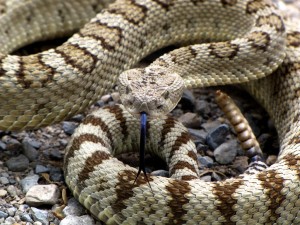 |
| The Great Basin Rattle Snake is a reptile that lives in rocky, brushy desert in Nevada. Adults can grow to about 4-5 feet in length and they feed on other reptiles, eggs, birds, and small mammals. Rattlesnakes use their tongues and pits in their heads to sense heat and vibration for finding food and avoiding danger. Shy and solitary, they tend to slither away and strike at people only when cornered or startled. |
| Click Here for the Nevada Department of Wildlife’s website |
| Video Link Click Here |

Rata Canguro (Dipodomys ordii)
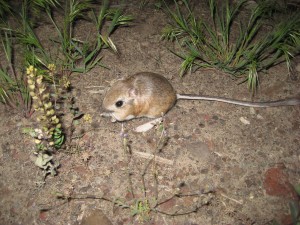 |
| The Kangaroo Rat is a native, threatened small mammal to Nevada. It lives in desert grasslands and prefers areas vegetated by sagebrush. The Kangaroo Rat can be recognized by its long tail with a tuft at the end. It has a small, pointed head with big ears and hops around. Kangaroo rats are very well adapted to dry environments. They may go an entire lifetime without a drink of water, getting moisture from their food. They also plug the burrow entrance in daytime to reabsorb moisture from their breath. |
| Click Here for Bird and Hike Website. |
| Video Link Click Here |

Badger (Taxidea taxis)
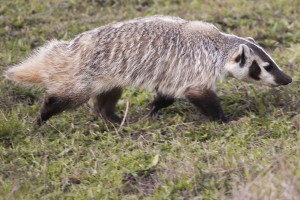 |
| Badgers can be found in remote and rural deserts in Nevada that have sandy soil. Adults are about 8-10 pounds with a flat body and loose skin. They are slow runners, but compensate for this by digging burrows in seconds. They are also very quick to defend themselves with their sharp teeth and claws. Badgers feed on rodents of all types. |
| Click Here for the Nevada Agriculture website |
| Video Link Click Here |

Mountain Lion (Felis concolor)
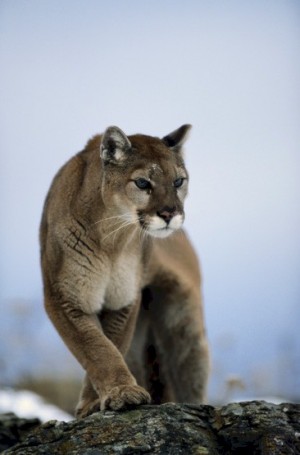 |
| The short dense fur of Nevada mountain lions varies from yellow, to tawny to rusty brown or gray. The underside of the body is white, and the tail is tipped in black. Mountain lions are adapted to a wide variety of habitats and environmental conditions found in Nevada. They prefer dense cover or rocky, rugged terrain, but also occur in desert areas. In Nevada, lion habitat is commonly associated with pinyon pine, juniper, and mountain mahogany. Two of the most important components of lion habitat are a source of meat and cover for hunting. Small mammals such as mice, ground squirrels, rabbits, skunks, and porcupines make up a large part of the mountain lion diet. Where abundant, mule deer are the primary prey species. Elk, bighorn sheep and feral horses are also taken by mountain lions. One lion can consume up to thirty pounds of meat at one meal. |
| Click Here for the Nevada Department of Wildlife website |
| Video Link Click Here |

California Quail (Callipepla californica)
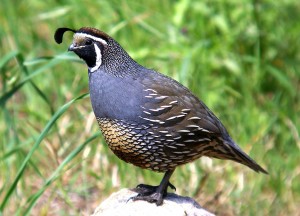 |
| California Quail are common throughout the watershed with habitat ranging from brushy chaparral foothills and live-oak canyons to adjacent desert and suburbs. The male California Quail claims his territory by cackling and posturing. The entire family takes to trees for roosting as well as for safety. After the breeding season, these birds become very social. California Quail are a stocky, mainly gray quail with a curved black head plume. |
| Click Here for the Audubon website |
| Video Link Click Here |

Quaking Aspen - Populus tremuloides
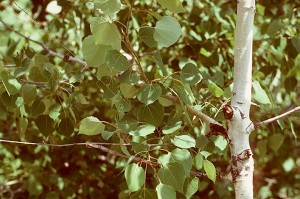 |
| Quaking Aspen - Populus tremuloides – Quaking Aspen is native along streams in mountain areas of the watershed at elevations of 6,000 feet to 9,000 feet. Standing 60 feet in height and 15-30 feet wide, the aspen provides important cover for many wildlife species. The bark of the Quaking Aspen has a smooth texture ranging in color from pale green to white. In contrast, the foliage is green in the summer with striking displays of yellow and red in fall. |
| Video Link Click Here |

Black Cottonwood – Populus trichocarpa
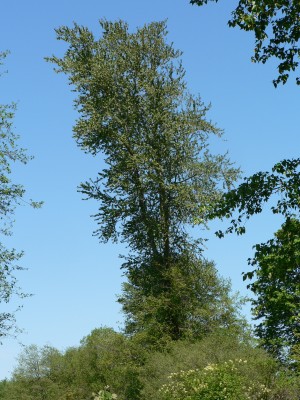 |
| Black Cottonwood – Populus trichocarpa – Black Cottonwood is very flood tolerant, growing along streams in the western mountains of the Carson River Watershed. Standing at 100 feet tall and 25 feet wide, the Black Cottonwood provides food, nesting, and cover sites for wildlife. The leaves of the Black Cottonwood are glossy and green with a silvery underside. In spring, the tree produces purple to red flowers. |
| Video Link Click Here |

Incense Cedar
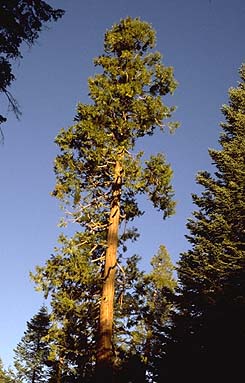 |
| Incense Cedar – Calocedrus decurrens – Native to the mountains of western Nevada and much of California, the incense cedar averages 75-90 feet in height spreading 10-15 feet. The scented rich green foliage of the Incense Cedar contrasts its cinnamon-colored bark. In full the sun the Incense Cedar will create lush, full foliage. However, if the tree is in a shaded habitat, the foliage may appear thinned out. Once these trees reach a certain age, the foliage tends to be sparse towards the top of the tree. Cedar is often used commercially due to its resistance to decay. Common items made of Cedar include chests, railroad ties, and shingles. |
| Video Link Click Here |

Jeffrey Pine – Pinus jeffreyi
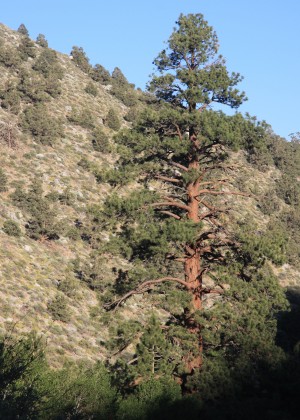 |
| The Jeffrey pine, 60-120 feet tall, is a long-needled yellow pine found at higher elevations than its relative the Ponderosa pine. The needles are gray to blue green and come in three needles per bundle. The cones can be up to 12 inches in length, with inward growing spines giving it the name “gentle Jeffrey.” As the tree ages, the bark appears purple in color and scents of vanilla or pineapple may be detected. |
| Click Here for Trees For Me website |
| Video Link Click Here |

Sugar Pine – Pinus lambertiana
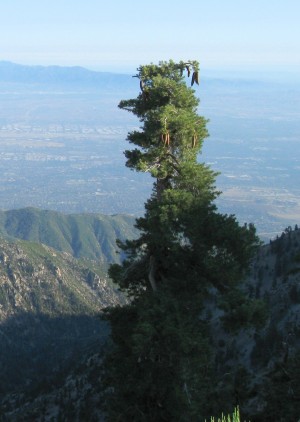 |
| The majestic sugar pine is the king of mountain pines at 200 feet in height and 50 feet wide. The branches reach out and 10-20 inch cones hang off the ends. The needles come five needles per bundle and are dark bluish green. This is the world’s tallest pine. It grows in moist places. The huge cones can hurt people, animals, homes, and vehicles when they fall. Some trees in the Sierra have been found to be over 500 years old. |
| Click Here for Gymnosperm Database website |
| Video Link Click Here |

Utah Juniper – Juniperus osteosperma
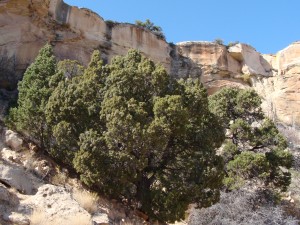 |
| Not only is the Utah juniper found growing in pinyon forests, it also grows in areas below the limits of pinyon on low hills and into valleys above the desert. This may be the most important tree in the Great Basin since it covers more area than any other Great Basin tree. It thrives in stressful and drought-ridden areas between 3,000 feet and 8,000 feet elevation. Its foliage is yellowish-green, coarse, and feels like coral that is not quite hard. The trunks are short and often forked with rough reddish-brown bark. It has berry like cones one-half inch in diameter. It rarely attains 30 feet in height with a 30-inch spread. Historically, across the west, Native Americans used the wood in building their houses. They ate the berries; smoked the bark; made shoes, clothing, and rope from it. |
| Click Here for California Native Plant Society website |
| Video Link Click Here |

Beef Production
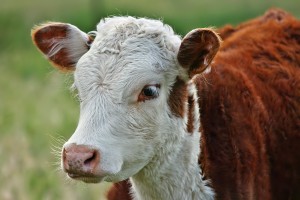 |
| Roughly 70,000 cattle live in the Carson River Watershed. Many beef cattle breeds are represented but the Hereford/Angus cross is the most popular. Each year cows give birth to their calves, typically in February and March. Beef cattle graze pastures and rangelands in the spring, summer and early fall and are fed hay in the winter. |
| Click Here for Hereford website |
| Video Link Click Here |

Llama
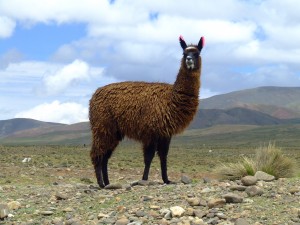 |
| Llamas are popular companion animals. People enjoy their curious nature and use them to pack light loads, carry small children, or even train them to pull carts. Adult llamas weigh between 300 to 450 pounds and stand about 5 to 6 feet tall at the head.. |
| Click Here for National Geographic website |
| Video Link Click Here |

Poultry
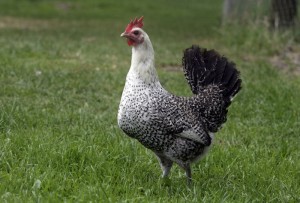 |
| Poultry or domestic fowl, include chickens, ducks and geese and do not exist in large numbers in the Carson River Watershed. Poultry are raised for eggs and meat. |
| Click Here for Encyclopaedia Britannica website |

Sheep
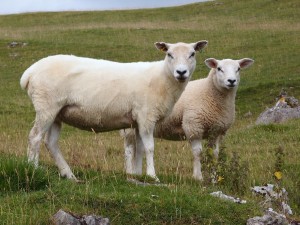 |
| A female (ewe) and male (ram) produce babies (lambs) for meat and wool. About 6,500 sheep live in the Carson River Watershed. Sheep are sheared in the spring and the wool is used to make many things we use, especially clothes. |
| Click Here for Encyclopaedia Britannica website |
| Video Link Click Here |

Alfalfa (Hay)
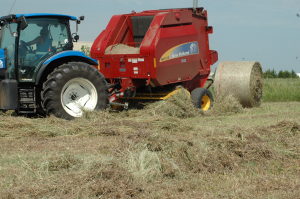 |
| Hay is the largest crop grown in the Carson River Watershed, as well as in the entire State. Hay includes alfalfa, grass and small grain crops. Over 250,000 tons of hay is grown in the watershed each year. |
| Video Link Click Here |

Garlic and Onions
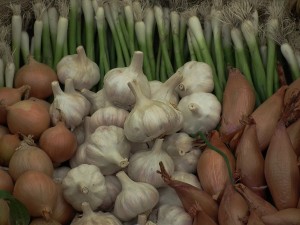 |
| Garlic is primarily grown in the Carson River Watershed for seed to plant in other states. Onions are grown to sell at the store and are also dehydrated to use as food seasoning. These crops are usually grown on a piece of land only one year out of seven to avoid diseases to the onions and garlic. |

Dairy
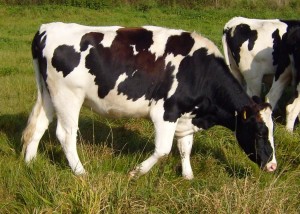 |
| Over 10,000 dairy cattle live in the Carson River Watershed. Dairy cows are usually milked twice a day and each cow produces about 5 gallons of milk per day. The black and white breed is the Holstein. |

Horse (Equus caballus)
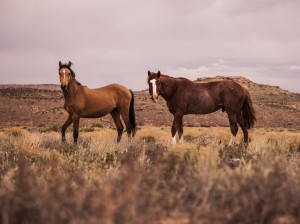 |
| The number of domestic horses that live in the Carson River Watershed is unknown but believed to be increasing at a rapid rate. Most horses are used for pleasure or leisure riding. Some are used in competitive horse shows or endurance events. |

Melons
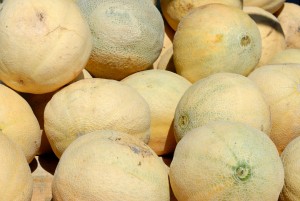 |
| Melons are grown in the Lahontan Valley. The most famous melon grown in is the “Hearts of Gold” cantaloupe but other melon varieties are also raised. The cantaloupe festival and County Fair are held in Fallon in September to celebrate the famous melon. |

Wild Horses
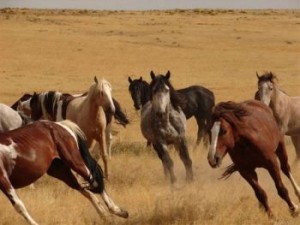 |
| Nevada is home to over 50 percent of the nation’s wild horses. Many of these horses are found in the Carson River Watershed, primarily in the Virginia Range Wild horses are considered by many to be living symbols of the historic and pioneer spirit of the west. |
| Click Here for Bureau of Land Management website |
| Video Link Click Here |

Rainbow Trout (Oncorhynchus mykiss)
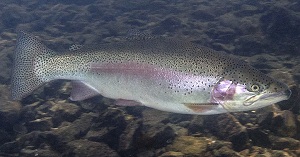 |
| Rainbow Trout is widespread across the world, due it’s transportation and popularity as a sport fish with anglers. In the Carson River Watershed, it is present in many waterbodies. They have an olive to greenish-blue color on the back and a white to silver belly with a stripe down its sides of red or pink. They are originally native to the west coast and prefer clear, cold water and a complex habitat of riffles, runs and pools. They spawn in tributaries with gravelly bottoms to protect the eggs. Offspring will remain in the spawning habitat for one or two years before migrating downstream to a larger stream or lake. |
| Click Here for the Nevada Department of Wildlife’s website |
| Video Link Click Here |

Western Pond Turtle (Actinemys marmorata)
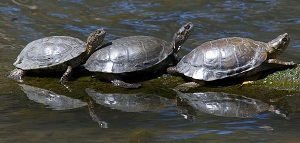 |
| Western Pond Turtles have a marbled pattern on their underside and soft parts with a low, broad, smooth shell which is usually light to dark brown or olive. Despite being called pond turtles, they spend most of their time in rivers or on land. Western Pond Turtle populations have been in decline for decades. They are threatened by loss of wetland habitat, dams, introduction of non-native species like bullfrogs and bass who eat the young turtle hatchlings. Turtles play an important role in ecosystems by eating decaying plant and animal matter, as well as providing food for native plants. |
| Click Here for Turtle Conservation Website |
| Video Link Click Here |

Lahontan Cutthroat Trout (Oncorhynchus clarkii henshawi)
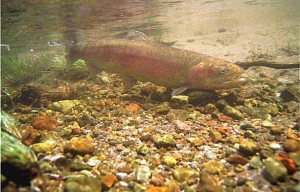 |
| The Lahontan Cutthroat’s name was derived from the lake it once resided in, the ancient Lahontan Lake of northern Nevada, eastern California and southern Oregon that receded nearly 12,000 years ago and now makes up what is now known as the Lahontan Basin. When this large ancient lake diminished, the Lahontan cutthroat trout were left with the Pyramid, Walker and Summit lakes, as well as the tributaries and main waters of the Truckee, Walker, Quinn, Carson, and Humboldt rivers of the area. This cutthroat now exists in about 10 percent of its historic stream habitat and only one percent of its past lake habitat from the early 1900s. The Lahontan cutthroat is both a river- and lake-residing fish. |
| Click Here for Lahontan Cutthroat Trout Website |
| Video Link Click Here |

Yosemite Toad (Anaxyrus canorus)
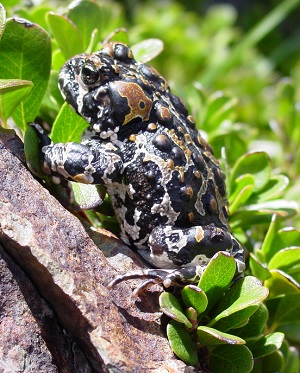 |
| The Yosemite Toad is endemic to the Sierra Nevada Mountains of California. As such, they are found in higher elevations (4,800-12,000 feet) and prefer wet mountain meadows, willow thickets and the edge, or ecotone, of where forests transition into meadows. They prefer to be near a permanent lake or stream. They are robust and stocky with a warty skin. Males and females differ in appearance, with males exhibiting a pale, yellowish green or olive color while females and young are heavily blotched on a light background. They can hybridize with the California Toad. The Yosemite Toad is classified as endangered because it is threatened by extinction. Its population has decreased by half, as well as disappeared from over 50% of its historic range. They have even disappeared from habitats that appear to be unaltered. As such, the causes of population decline are not fully understood. Some possible causes include climate change, disease, introduced predatory fishes, habitat loss from grazing livestock and predation by Common Ravens. The Chytrid fungus, which has been the culprit for decline in Mountain Yellow-Legged frog populations, may also be affecting these toads as well. |
| Click Here for California Herps Website |
| Video Link Click Here for Yosemite Toad Mating Call Video |
| Video Link Click Here for Saving Yosemite’s Frogs Video |

American Kestrel (Falco sparverius)
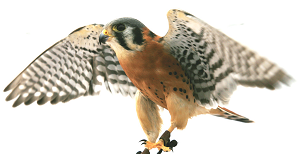 |
| American Kestrels are in the falcon family and are widespread across North America. American Kestrels have been successful at adapting to many different habitats like forest clearings, farmland or deserts. American Kestrels may be limited to habitats that provide appropriate nesting sites as they often nest in cavities in trees or in places where there are nesting boxes provided by conservationists. Their diet consists mostly of large insects, other birds and reptiles. In the Carson River Watershed, they may enjoy snacking on Western Fence Lizards which are abundant. Grasshoppers, however, are one of their favorite treats. They hunt mostly by watching from a high perch before swooping down to capture their meal. Individual kestrels often specialize on one kind of prey. During mating season, females typically attract males by flying slowly with stiff, fluttering wingbeats. Males will fly high, make a call, then dive. Males will also bribe the females by bringing them food, which they pass to them in flight. |
| Click Here for Audubon Website |
| Video Link Click Here for American Kestrel Video |
| Video Link Click Here for American Kestrel Documentary Video |

Coyote (Canis latrans)
 |
| The coyote is a member of the dog family (Canidae) and resembles a medium-sized shepherd-collie type dog. Distinguishing characteristics include sharp pointed ears, a pointed nose, and a long bushy tail. From the low desert valleys to the alpine ridges coyotes are found in about any type of habitat where they can find food and a place to hide. They seem to show some preference for brush covered rolling hills and flats. Coyotes have perhaps the most varied habitat of any animal in Nevada. Coyotes will eat almost anything available to them where ever they are; fruits, rodents, small animals, and garbage. Communication helps coyotes to maintain their social structure. The most distinctive of their calls is barking and yelping followed by a long howl that is followed by short, sharp yaps. This broadcasts their location to other members of their group. |
| Click Here for Nevada Department of Wildlife’s website |

Long-Tailed Weasel (Mustela frenata)
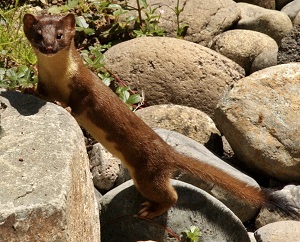 |
| Long-Tailed Weasels have long, slender bodies and short limbs with five toes. The tail is half the length of their body and has a black tip. They often have brown bodies with a yellow belly fur. Their coats can change to white in the winter. Long-Tailed weasels are found throughout southern Canada, the United States, and down through Mexico to South America. They do not hibernate during the winter and are primarily nocturnal, although they can be seen during the day time too. Long-tailed weasels are quick and agile. They are good tree climbers and can cross swift streams. They make their nests out of grass, rodent and rabbit fur. When threatened, they release a bad smelling musk odor. Long-Tailed weasels are the largest weasel of the weasel family and are known to boldly attack prey up to twice its size. |
| Click Here for NDOW website |
| Video Link Click Here for Winter Weasel |
| Video Link Click Here for Weasel in a Hole |

Wild Burro (Equus asinus)
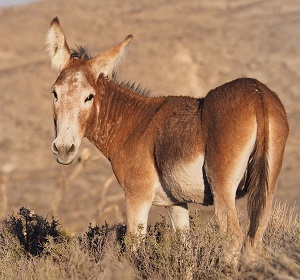 |
| Wild Burros were introduced into the southwest deserts by the Spaniards in the 1500’s. They have long ears, a short mane and can be up to 5 feet tall. They are often brown or grey in color. Burros originated in Africa, where they were used as hardy pack animals in an arid environment. Adapted to a dry climate, they can lose up to 30% of their body weight in water and replenish it in 5 minutes of drinking. Wild Burros can be seen foraging on grasses, Mormon Tea, and other vegetation. Wild Burros were used as pack animals by prospectors who searched the region for gold and silver. Burgeoning Burro populations have harmed native plants and animals by how successfully they compete for resources. |
| Click Here for DesertUSA website |
| Video Link Click Here for Foraging Burros |
| Video Link Click Here for BLM Burro Video |

Pygmy Rabbit (Brachylagus idahoensis)
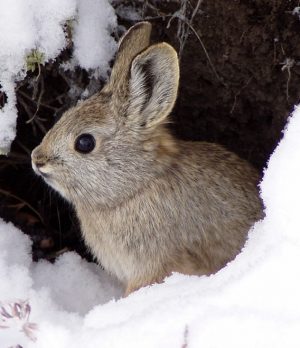 |
| Pygmy Rabbits are the smallest native rabbit in north America and can even fit in your palm! Depending on the season, their fur can be brown to slate grey in color. They have short ears and a small tail and eat mainly sagebrush. Pygmy Rabbits are considered as a species of special concern in Nevada and endangered in Washington. Causes for these classifications are low population size, habitat loss, predation and introduced diseases. Since Pygmy Rabbits prefer old-growth sage brush stands, the most effective conservation practice is to preserve sagebrush lands. Pygmy Rabbits build burrows in deep, loose soil amongst the sagebrush. |
| Click Here for NDOW Website |
| Video Link Click Here for Pygmy Rabbit Conservation |
| Video Link Click Here for Pygmy Rabbits Hopping to Freedom! |

Yellow-Billed Cuckoo (Coccyzus americanus)
 |
| Yellow-billed Cuckoos have disappeared from some western areas while it remains endangered in others. The biggest cause of population decline is habitat loss. They prefer woodlands, thickets, orchards and riparian areas. This bird is often found in dense, leafy groves and thickets in the summer and can be heard calling on hot days. Because of this, it is sometimes called the rain crow, as if it is calling for rain. In fact, when they make this call a storm or raincloud is usually rolling in, making them good predictors of an impending rainstorm. During mating season, the male courts the female by feeding her. For food, they like to eat mostly caterpillars but will eat other insects as well. Their population numbers often rise and fall with insect outbreaks. |
| Click Here for Audubon Website |
| Video Link Click Here for Yellow-billed Cuckoo |
| Video Link Click Here for Yellow-billed Cuckoo Having Dinner! |

Willow Flycatcher (Empidonax traillii)
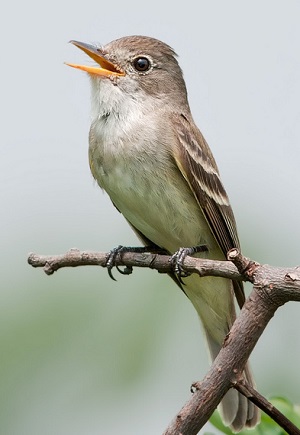 |
| Willow Flycatcher population size has drastically declined in the Sierra Nevada since the 1950’s. As such, they are listed as endangered in Nevada and California due to habitat loss and destruction. They prefer to nest in thick willow stands in meadows and require deep standing or running water nearby. Causes of habitat loss are from trampling livestock, construction, water diversion, fire suppression and climate change. Fencing stream and meadow areas has been a successful conservation measure to protect Willow Flycatcher habitat. They eat mostly insects but may also eat a few berries and seeds. |
| Click Here for Sierra Forest Legacy Website |
| Video Link Click Here for Willow Flycatcher Call |
| Video Link Click Here for Balancing Ranching and conservation |
